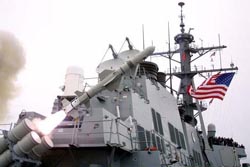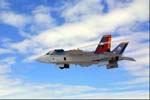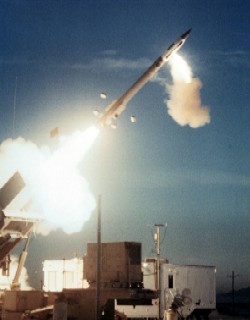Page 1
Daily News
By Gail Helmer
| Send Us News | Archives | Main |
Monday October 20, 2001
Military News
- US Navy Completes Testing Of Harpoon Block II Missile
- GAO Repeats Assertion That JSF Not Ready For EMD
- PAC-3 Missile Intercepts Advanced Cruise Missile Target
- Two U.S. Servicemembers Die In Helicopter Crash
- Taliban Ability to Respond to Airstrikes "Falling Away"
- Silent Hunter II Goes Gold
- Hotas Cougar Delayed
- Rogue Spear: Black Thorn Demo
- WW2OL Patch Update
US Navy Completes Testing Of Harpoon Block II Missile
The US Navy recently completed developmental testing of the new Harpoon Block II missile at the Naval Air Warfare Centre-Weapons Division sea range off Pt. Mugu in California.
In this most recent and final test, the missile was launched from the USS Decatur (DDG-73), an Arleigh Burke-class guided missile destroyer, against a mobile ship target close to land.
"The Harpoon Block II missile has successfully demonstrated its effectiveness against sea, land and littoral targets," said Jim O'Neill, Boeing general manager of Navy Missile Systems. "We can now provide our customers with a low-cost, low-risk approach to protecting waterways and littoral regions."
Harpoon Block II provides accurate, long-range guidance for coastal and ship targets by incorporating the low-cost inertial measuring unit from the Boeing Joint Direct Attack Munition program, and the mission computer and Global Positioning System receiver/antenna from the Boeing Standoff Land Attack Missile Expanded Response (SLAM-ER). Existing SLAM-ER navigation and land-strike software and proven Harpoon ship-attack software are the foundation for major portions of the Block II mission software.
"The Block II developmental effort clearly demonstrates that infusing leading-edge technology into mature and proven weapon systems, such as Harpoon, can produce extraordinarily effective operational capabilities," said the US Navy programme manager for Standoff Missile Systems.
Harpoon Block II can carry out both anti-ship missions and coastal target suppression. For conventional anti-ship missions, such as open-ocean or near- land, the inclusion of GPS/INS improves guidance directly to the intended target. The accurate navigation solution allows the Navy to discriminate ship targets from islands, other obstructions or neutral ships. To strike targets on land and ships in port, the missile uses GPS-aided inertial navigation to hit a designated target aimpoint.
The 500-pound blast warhead is effective against a wide variety of land-based targets, including coastal defence sites, surface-to-air missile sites, exposed aircraft, port/industrial facilities and ships in port.
These Block II improvements will maintain Harpoon's high-hit probability even against ships very close to land and in congested waterways. The multi-mission Block II missile can be deployed from all current Harpoon missile system platforms with either existing command and launch equipment or the new Advanced Harpoon Weapon Control System.
Numerous foreign countries are considering the Harpoon Block II missile under US foreign military sales agreements. Deliveries could begin in January 2002.
GAO Repeats Assertion That JSF Not Ready For EMD
As the US Department of Defense approaches decision day on the down select for the Joint Strike Fighter the GAO, the US' Government's spending watchdog maintains that the technology for either contender is still not mature enough to allow the project to go forward to the engineering and manufacturing development (EMD) phase.
The JSF Programme is the most expensive aircraft programme in the DoD. It is intended to produce affordable, next-generation aircraft to replace ageing aircraft in the military services' inventories. As currently planned, the programme will cost about $200 billion to develop and procure about 3,000 aircraft and related support equipment. Two contractor teams, led by Boeing Company and Lockheed Martin are competing for the EMD phase. This phase of the programme is projected to last about 8 years and cost about $20 billion and typically involves large, fixed investments in human capital, facilities, and materials.
In May 2000 the GAO reported that a key objective of the programme's acquisition strategy is affordability and that a part of that strategy (entering into EMD with low technical risk) would not be achieved because technologies critical to meeting the programme's cost and requirement objectives were projected to be at low levels of technical maturity in April 2001, the date then scheduled for awarding the engineering and manufacturing development contract.
The GAO, based their assessment on study of organisations that use best practices, contends that delaying the resolution of technology problems until product development, analogous to the EMD phase, can result in at least a ten-fold cost increase; delaying the resolution until after the start of production could increase costs by a hundred-fold.
Although it agrees that the Joint Strike Fighter programme has made good progress in some technology areas, the GAO says the programme is at risk of not meeting its affordability objective because critical technologies are not projected to be matured to levels that it believes would indicate a low risk program at the planned start of engineering and manufacturing development in October 2001. The GAO says the critical technologies are projected to be at the same level of maturity in October 2001 as they were projected to be in April 2001, the previous scheduled date for the EMD contract. Several of these technologies under development are critical to making the long-term ownership costs of the program affordable.
These technologies remain at higher risk levels for engineering and manufacturing development because (1) they have not been developed to approximately the same size, weight, and configuration of the end product and/ or (2) they have not been demonstrated to work in an environment similar to the planned operational system. For example, the contractors have demonstrated certain key component technologies in flight environments, but the tested hardware was not always the same size and weight required for the Joint Strike Fighter aircraft. In other instances, components built to the required size and weight were only demonstrated in ground-tests. The GAO would not give specific examples of such shortfalls because of the ongoing competition.
Commenting on the report, DoD said that it assessed the technology maturity of the Joint Strike Fighter to be sufficient for the next phase of the programme. DoD also said that the Joint Strike Fighter Program Office has implemented a rigorous risk management programm that would continue to monitor and address technology risks, as well as other risks, throughout the program's life.
The GAO disagrees "...with DOD's assertion that technology is mature enough to move forward. The technology readiness level assessment conducted as part of our review of the Joint Strike Fighter showed that critical technologies are not projected to be matured to levels that would stem risks at the start of engineering and manufacturing development. Our previous work has shown that when programmes proceed in this fashion, they experience delays, rework, and substantial cost increases that could force the Department to divert much-needed funds from other important weapon system programmes."
PAC-3 Missile Intercepts Advanced Cruise Missile Target
The Patriot Advanced Capability-3 (PAC-3) Missile programme completed its Developmental Testing today by intercepting and destroying an advanced cruise missile target at White Sands Missile Range in New Mexico. The target BQM-74 cruise missile was flying at a very low altitude in a cluttered background. The programme now moves into the Operational Testing phase.
The PAC-3 Missile boasts 12 successes out of 13 missile flights over the past three years, with nine intercepts in 10 attempts, an overall 92 percent success rate for the flight test programme.
The PAC-3 Missile, now in low-rate production, is a high velocity, hit-to-kill missile and is the next generation Patriot missile being developed to provide increased capability against advanced theater ballistic missiles, cruise missiles and hostile aircraft. The PAC-3 Missile defeats incoming targets by direct, body-to-body impact. The PAC-3 Missiles, when deployed in a Patriot battery, will significantly increase the Patriot system's firepower, since 16 PAC-3 Missiles load-out on a Patriot launcher, compared with four of the old Patriot missiles.
"The PAC-3 Missile has been tremendously successful during Developmental Testing," said Jim Berry, president of Lockheed Martin Missiles and Fire Control. "We have proven conclusively through these tests that the PAC-3 Missile is fully capable of defeating the entire threat to the Patriot air defence system: tactical ballistic missiles, cruise missiles and aircraft. "
"The Army continues to be quite pleased with the performance of the PAC-3 Missile and the upgraded Patriot ground equipment," said Col. Tom Newberry, Lower Tier Air and Missile Defense project manager. "Today's PAC-3 flight test success further demonstrates the effectiveness of this important theatre air defense system, and underscores the confidence we have in its ability to defeat today's sophisticated threats."
"For the projected US Army production run on PAC-3, we've been able to achieve cost-savings that place the average unit price of the missile just above $2 million each. And when we add expected foreign PAC-3 Missile production, we're talking about a missile that will be well below the $2 million mark," said Berry.
Lockheed Martin Missiles and Fire Control, Dallas, Texas, is the prime contractor responsible for the PAC-3 Missile segment upgrade to the Patriot air defense system, which consists of the PAC-3 Missile, the missile canisters, the Fire Solution Computer and the Enhanced Launcher Electronics System.
Two U.S. Servicemembers Die In Helicopter Crash
The Department of Defense announced today the names of two servicemembers killed in Friday's helicopter crash in Pakistan. Killed were Spc. Jonn J. Edmunds, 20, of Cheyenne, Wyo. and Pfc. Kristofor T. Stonesifer, 28, of Missoula, Mont.
The two Army Rangers were passengers in a Blackhawk helicopter that crashed while supporting Operation Enduring Freedom. Hostile fire has been ruled out as a cause of the crash, which remains under investigation.
Gen. Richard B. Myers, chairman of the Joint Chiefs of Staff, offered his condolences to the families of those killed. "They and all who are participating in Operation Enduring Freedom are heroes. They put their lives on the line on behalf of freedom and on behalf of America, and they do it each and every day. I'm so very proud of them and their comrades in arms," he said.
"As the president has said," added Myers, "they did not die in vain."
Taliban Ability to Respond to Airstrikes "Falling Away"
The U.S. is using power in ways today that military tacticians never thought of before. And it's all aimed at reaching the nation's objectives of destroying the instruments of power the Taliban uses to support Osama bin Laden's Al Qaeda terrorist network, said Rear Adm. John D. Stufflebeem, the Joint Staff's deputy director of operations for current readiness and capabilities.
"We're systematically attacking those elements of the Taliban military that will take away the Taliban's capability to support Al Qaeda," Stufflebeem told reporters Oct. 17 during a Pentagon briefing. "Where those cross in support of the Northern Alliance objectives is a good thing."
As U.S. aircraft attack the Taliban and Al Qaeda in Afghanistan, there are no "reports that they are returning fire on our aircraft," he said. However, Stufflebeem, a Navy pilot, pointed out that a pilot could be shot at and not know it.
"Our sense is that the Taliban's ability to respond is falling away," Stufflebeem said.
With the reduction in the air defense threat, U.S. aviators started using a new tactic on Oct. 16 called an "engagement zone." Stufflebeem said "flex targeting" was used to hit those sites -- a bomber flew to a target, returned to a tanker and was then sent to another target.
"That's using bombers in ways we've never done before," Stufflebeem noted.
In the first use of engagement zone doctrine, the admiral said the aircraft struck 12 planned target areas, which included airfields, air defenses, dispersed armor, radar, ammunition, vehicle storage depots, artillery camps and military training facilities, including armored vehicles, trucks and buildings.
"About 90 to 95 strike aircraft were used in the attacks," Stufflebeem said. "About 85 of them were carrier-based tactical jets, five land-based bombers and less then five were AC-130 gunships."
He said the AC-130 brings special capabilities to the battle.
"A pilot who is given a mission in an engagement zone knows what type of target he'll go against mobile armor, mobile surface-to-air capability," Stufflebeem said. "A forward air controller will find those targets and pass them to the pilots to attack. So the sense that there is any freewheeling or self-determination is not correct."
He said if pilots spot targets of opportunity, they call controllers and they make positive identification before assigning aircraft to attack them.
Stufflebeem said Oct. 16 airstrikes involved military facilities in southern Afghanistan, including a garrison facility of the 2nd Taliban Corps where barracks were hit. The images also showed where vehicles were destroyed in a Taliban bivouac area.
Stufflebeem said the Department of Defense does not have any information about the Northern Alliance taking the northern Afghanistan city of Mazar-e Sharif as some have reported. He characterized the battle between the Northern Alliance and the Taliban as "ebbing and flowing."
He told reporters he wouldn't characterize "what we're doing today or what we'll do in the future." But he reiterated that the U.S. is continuing to support its campaign objectives and where they cross with those of the Northern Alliance there is a "mutual benefit."
Asked if U.S. gains in Afghanistan would be reversed if there was a bombing pause to allow humanitarian relief groups to do their jobs, Stufflebeem said, "There is nothing we're doing that should prevent the nongovernmental organizations from doing what they need to do. But I have seen reports that the Taliban is preventing them from doing what they should be doing. We're supporting all efforts.
"It's inefficient to provide humanitarian support from the air -- it's most efficient when it's done from the ground," Stufflebeem pointed out. "We would do anything to encourage nongovernmental organizations to be able to help those who need it. I think it's the Taliban preventing that more than it is our strikes."
He said, "one of our missions hit a Red Cross warehouse that stored humanitarian goods. This building was within a set of targets we had identified as being used for military storage by the Taliban."
He said the Air Force continues to fly C-17 humanitarian missions.
"We delivered about 53,000 humanitarian daily rations. Four C-17 airdrop missions delivered those yesterday," Stufflebeem said. "To date, we've had nearly 400,000 daily rations dropped."
PC News
Silent Hunter II Goes Gold
Ubi Soft Entertainment and SSI today announced that Silent Hunter II has reached gold master status. Silent Hunter II will begin shipping to retail stores the first week of November. The companion title Destroyer Command is expected to reach store shelves by Christmas.
Hotas Cougar Delayed
We received some news that the Hotas Cougar release date has been delayed until January 2002. No word on what caused the delay, but we will keep you posted.
Rogue Spear: Black Thorn Demo
Ubi Soft has told us that a Rogue Spear: Black Thorn demo will be available Friday, October 19. Rogue Spear: Black Thorn is the latest add-on and will be in stores on November 1st 2001. Black Thorn Website
WW2OL Patch Update
A small bugfix patch, v1.3.1, has been released to address problems players were experiencing with v1.3.0 released earlier this week. Click here for further details
| Send Us News | Archives | Main |



